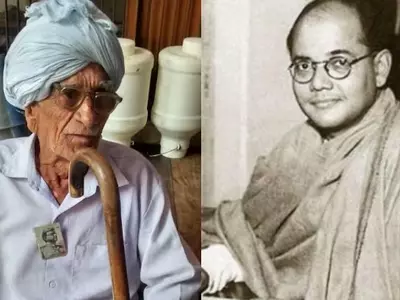Kundan Singh - The Personal Valet To Netaji Subash Bose At The INA Headquarters Passes Away. Here Is His Full Story.

Kundan Singh (98), the personal valet of Netaji Subash Chander Bose breathed his last on Monday. A resident of Bahadurgarh, a small town in Haryana located on Delhi North-West border, Kundan Singh didn't acquire much fame like many others who claimed to be Netaji's very own. But he was one of those who believed in the conjectures that Netaji was alive till the mid-1970s and went to Dehradun in search of his ideal.

Maninder Dabas/IndiaTimes
In the last few years if his life, Singh couldn't understand most of the things going on around him. But a slight mention of Netaji would make him rise like a phoenix and he would be narrating the tales of the Indian National Army, and Netaji Subash Chander Bose in particular. Kundan Singh was one of the few lucky ones who saw, lived and learnt from Netaji's life when he served as a personal valet to Netaji Subash himself, during a brief period of more than a year, in Singapore.
"We will always remember him as a freedom fighter and would want the government to remember him like that as well. We grew up while listening to the tales of Netaji and INA from my uncle. And till last days of his life, he remembered Netaji as his ideal. Though neither the Centre nor the state government ever came forward to reward him for his services to the nation while he was alive, I would request the government to name a road after him so that he always remain alive in memories of the people," Dilbag Singh, nephew of late Kundan Singh told Indiatimes.
Dilbag Singh also told IndiaTimes that none of the representatives of the state government came to his last rites except for the SDM of Bahadurgarh who gave Rs 5100 from the side of the government to cremate him.
Bose, the prodigal son of the Indian freedom struggle, is believed to be mistaken by history and, of course, forsaken by destiny. But Kundan Singh doesn’t believe he died in that crash on August 18th 1945 in Taiwan.
“He couldn’t have died. Netaji didn’t die. He was the master of disguise and mischief. Don’t you remember his escape from Calcutta as a Pathan in 1940? Habib ur Rahman Khan, his fellow commander who flew with him that day later came out with his watch as the evidence of his death, but none of us bought it,” shouted Kundan Singh when IndiaTimes spoke to him in August 2016.
Here is the inspiring story of Kundan Singh, the man who lived with Netaji as a shadow in his INA days in Singapore during World War-II
How Kundan met Netaji Subash
Kundan Singh joined the British Indian Army on November 10, 1940, and was straightway thrown to the frontiers of World War-II in Singapore to face the menacing Japanese. In September, 1942, when Singapore fell before the Japanese led by first INA Commander Mohan Singh under the Malayan campaign, Kundan Singh, along with almost 50 thousand soldiers, was taken as a Prisoners of War (POW).
Many of them joined INA and in 1943, Singh was one of the lucky ones who got a chance to become one of the personals bodyguards of Netaji himself. “Throughout his life, he never kept bodyguards when he was out. We only remained with him in headquarters, earlier in Singapore and later in Rangoon. Working in INA was a dream come true because there was no discrimination as it was in the British Indian Army I was first inducted in,” had added Singh who claims that in British Indian Army, Indian soldiers were discriminated against.
Kundan had explained discrimination
Singh further says that in the British Indian Army, a white soldier with a similar rank to his used to get Rs 34 as salary whereas the Indian soldiers used to get half of it. Apart from less salary, discrimination was prevalent at every step, including living conditions, food and even at the war front. According to Kundan, the British used to keep Indian soldiers at the front lines while facing the enemy whereas a British sepoy with a similar rank was to remain safe behind the wall of Indian soldiers. He also regrets that after the end of the World War, he along with several other soldiers were once again repatriated to the British Indian Army.
How Bose used to live

zeenews
Kundan Singh explains that Bose was an extremely disciplined and focused person. During his stay at the INA headquarters in Singapore and Rangoon, he used to be very cordial with fellow soldiers. "He was very focused about the cause of Indian Freedom from the British and he didn't want to let the opportunity of WW-II slip by as the British had gone weaker and it was difficult for them to maintain their rule in India. Bose wouldn't trust anybody and would go alone everywhere," adds Kundan.

Bose had immense respect for Gandhi and Nehru
Bose always had a conflict of opinion with other senior Congress leaders like Gandhi and Nehru and that was the reason he left and created the Forward Block. Some theories say that India's first PM, Jawaharlal Nehru, did fuel the conspiracy theory of his death and even got his family spied on. But Netaji didn't have any grudges. Kundan Singh says that Bose had great respect for both Nehru and Gandhi and had forged battalions in the names of these leaders in the INA.
“Bose had created Gandhi and Nehru battalions in the INA and had great respect for the leaders. He used to tell inspiring stories about the two leaders to motivate troops," adds Kundan.
Kundan Singh further laments that Netaji might have had a ‘conflict of opinion’ with Congress leaders, but they always took it as a ‘conflict of Interest’. Which is why top Congress leaders fabricated the tale of his death with the help of his commanders like Shahnawaz Khan and Habib ur Rahman, to cash in on the sympathy of the masses. In exchange, they defended their case in the famous Red Fort trials,” accused Singh who believes that Bose didn’t die and lived on for many years in Dehradoon and surrounding areas as a sadhu.
Habib ur Rahman later joined the Pakistan Armed forces after partition and played an important role in annexing half of Kashmir in 1947-48.
When Kundan went to Dehradoon in search of Bose

Maninder Dabas/IndiaTimes
“After retiring in 1946, I lived in my village but never believed the conspiracy theories of Bose’s death. Later in the 1950s, I, along with many of my friends, went to different asharams in Dehradoon where we heard of his presence. But we never found him. Yet the management of those ashrams was very similar to that of the small compound he used to acquire in INA. And it always cemented the rumour of Bose being alive,” added Singh who believes that Bose was never a stooge of the Japanese and was only concerned about the freedom of India from the British empire.
When the Government had asked Kundan about the treasury of INA in 1978
After Emergency was over, the Moraji Desai government in 1978 had formed a report about Netaji and the treasury of the INA. Kundan Singh was quoted in the report. An 18-page secret note, prepared for the Morarji Desai government in 1978, quotes Kundan Singh as saying that the treasure was in “four steel cases which contained articles of jewellery commonly worn by Indian women, chains of ladies watches, necklaces, bangles, bracelets, earrings, pounds and guineas and some gold wires."

Maninder Dabas/IndiaTimes
It also included a gold cigarette case gifted to him by Adolf Hitler. These boxes were checked before Netaji departed from Bangkok to Saigon. A leader of the Indian Independence League in Bangkok, Pandit Raghunath Sharma had said that Netaji took with him gold and valuables worth over Rs 1 crore. There was clearly much more of the treasure than the two leather suitcases burnt in the airplane crash.
Netaji had approached the Soviets
After the fall of Germany, it was evident that Japan would be defeated eventually. Therefore, Bose tried to approach the victorious Soviets to support the INA against the British. But unfortunately, he never reached Moscow and his plane crashed in Taiwan. “Bose always knew that INA won’t be able to liberate India own its own; but he believed that with the help of Japan, it could weaken the British to such an extent that they wouldn't be able to keep a hold on India for long,” said Singh.
Kundan Singh also accused the first government of Independent India of confiscating the gold reserves worth seven crores donated by the Indian diaspora in Burma and people in India to INA.
Where do we hear more tales of Bose?
Kundan, like most of his INA Sepoy friends, will probably rest in peace in a few years to come, and with him the glorious first-hand tales of Bose and his INA.

Maninder Dabas/IndiaTimes
“Although now I am unable to stand properly, I wish to salute Bose for one last time when I depart this life. I wish this country has such leaders in future, but I know my wish is unlikely to come true,” signs off Singh.
Nothing lasts forever, not even the relics. Kundan Singh was one of the few men who could enlighten us about the otherwise mysterious life of Netaji Subash Chander Bose. But with him gone, many of the tales about Bose and his heroics which have deliberately been sidelined till now forever remain caged in oblivion.
But may the soul of the great man rest in peace.

























